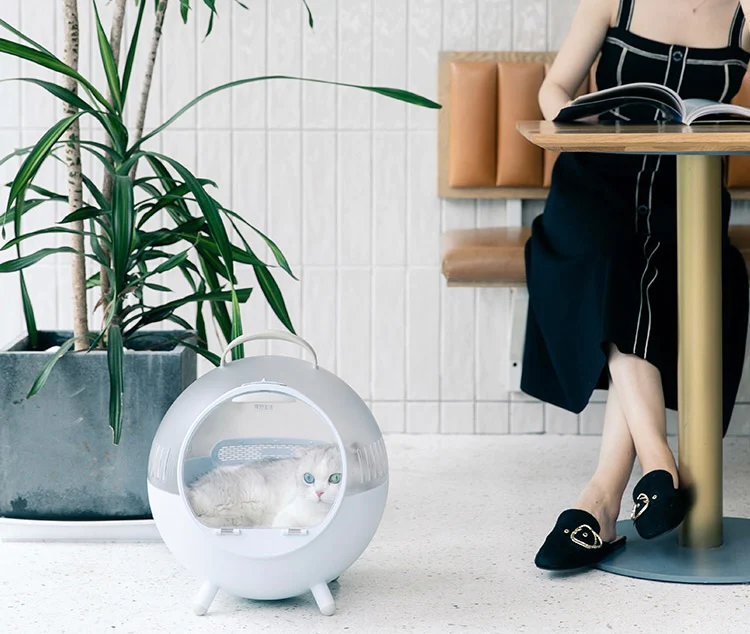Do you want to take your cat outside?
Cat lovers who want their cats to enjoy fresh air, sunshine, and the ambiance of trees, bushes, and plants, often feel guilt by confining their cats to the indoors. This was the mindset in previous generations: that cats were free and independent creatures and should not be confined. That they cannot be healthy, happy, and active, if not allowed to experience all the glories of the outdoors.
Come back with the question that many cat owners asking is: “Should I let my indoor cat go outside?” Some indoor cats love the outdoors and may even seem a little unhappy being cooped up. But at the same time, there are many dangers your cat could encounter if he’s allowed outside. Every cat is different, so you should weigh these risks carefully before making up your mind. For those who choose to avoid the risk, there are other options that allow your cat to still get some fresh air, like letting him out on a harness or inside a cat tent.
The Risks of Being Outside
Many cats enjoy the outdoors. They love to climb, feel the breeze on their faces, and chase bugs. Whether or not you let your indoor cat outside can be a tough call. But you might want to be aware of these potential risks before you open your door.
First, a cat’s lifespan is longer indoors. In general, indoor cats have a 15-17 year life expectancy compared to outdoor cats’ life expectancy of two to five years. That’s a big difference.
Busy streets, unexpected encounters with wildlife, and environmental and manmade toxins can all pose risks to outdoor cats. If you do let your pet out, you might want to only do so when the weather’s milder. Hot summer days or cold, freezing days can pose risks of their own.
Outdoor cats also pose a danger to other forms of wildlife, like birds.
Respecting Your Cat’s Individual Personality and Needs
Above all when weighing the pros and cons of the outdoor vs. the indoor life for your cat, it is important to remember two things. First, like people, every cat is different with individual personalities and different preferences, so what is best for one cat may not be right for yours. For example if you have adopted a stray cat, who has lived the roaming life, your new companion may likely be eager to go out. On the other hand, if your cat has had previously traumatic experiences with other animals perhaps she will be more than a little reluctant to venture outside again. A young kitten that has never been out of your flat, may or may not feel the pull of the outdoors. Secondly, there is no “right” or “wrong” side of the outdoor /indoor debate. Both outdoor and indoor cats can live full, satisfying, happy lives, provided you take some practical steps to make your cat’s outdoor or indoor environments as safe and stimulating as possible for your cat.
If you want your cat to enjoy the outdoors without the risks, there are a number of creative ideas you can try.
Carrying Your Cat
You can carry your cats around your backyard, allowing them to sniff and explore it. These explorations are best kept to a very short time—10 or 15 minutes—as most cats will become too eager to jump down and explore on their own. If you are considering bringing your cat outdoors, it would be best to try this first with your cat in a safe carrier such as their travel bag or a pet stroller. Unpredictable noises or other surprises can startle even the bravest cats when they are not accustomed to being outside. A scared cat could easy wriggle free and run away, or even unintentionally scratch or bite you in their panic. It would be best to give your cat time to adjust to these outings before attempting these next steps.
Leash Training
Some cats can be trained to wear a harness and leash, using a gradual method of training. Many cats will initially feel confined by the additional weight of the harness, and their first attempts at walking on a leash will appear to be more of the “slinking” or “belly-crawling” variety. Some cats may also find ways to slip out of the harness or tangle themselves in the leash, so it is best to practice indoors with short sessions to determine if your cat will tolerate this. Given time and patience on the part of the trainer, some cats will enjoy leash walking.
Please note that tying a cat outside on a leash is not a substitute for personal interaction and supervision. Cats should never be left alone with a leash or a rope extension attached to them. There is too much danger of them becoming tangled up, with the possibility of strangulation, as well as high risks of them slipping out of the leash and running away.
We recommend a sturdy harness or walking jacket, as opposed to a collar. Collars can be slipped too easily, which will most likely happen in times of fear, such as when meeting a strange dog or cat on the street, loud noises, fast-moving vehicles, or even approaching strangers. Also try to buy as lightweight a leash as possible, consistent with safety. The additional “drag” of a bulky leash will slow your cat’s walking progress.
Be sure to test your cat’s “leash quotient” indoors for several days before taking him outside. Slow introduction and short sessions will give you the best change of getting your cat acclimated to this idea and will result in a cat with a safe and happy indoor-outdoor experience. If after many sessions indoors with lots of positive reinforcement (treats and toys) your cat does not seem to be adjusting or is showing signs of stress or aversion to the harness, consider one of these other safe ways to introduce your cat to the outdoors.
A Personal Carrier
If you decide that you want to make your cat a “traveling cat,” we suggest purchasing a carrier that is comfortable and sturdy to give your cat a safe space to observe the outdoors. There are many kinds of carriers on the market as well, so make sure to choose one that gives your cat enough room to comfortably lay down and turn around. You may have to try a few different styles to figure out which one suits your cat best.
Wheeled Walker or Stroller
The Kittywalk Stroller provides both a durable nylon netting “cage” so kitty can enjoy the outdoor experience and a water-resistant canvas shade for protection from the sun. The Wheel Away converts to a backpack, car carrier, and bed. These stroller-style carriers can be a great option since they allow you to take longer walks with your cat without having to carry them, and it keeps your hands free for other things. Many cats feel safe if they have some privacy or space to hide so the partial shade can give them a sense of security in the great outdoors.
Outdoor Enclosures
For cats who would prefer to “free-roam” (within limits), outdoor enclosures are ideal. They can be built from scratch, with your own or purchased plans, or assembled as modular enclosures. A free-roam set-up requires you to have a private outdoor space where you can construct a permanent structure. The advantages are that it gives cats total freedom to wander and explore within a safe space. It will require ongoing maintenance to ensure the structure remains sound and that no defects form over time that could cause injury or be a site where cats could escape.
Your experiences may vary with any or all of these means of providing a safe outdoor experience for your cats, but we think you’ve been given enough alternatives here to get you started. You could visit our shop to find something you need for your cat’s outdoor adventure!













